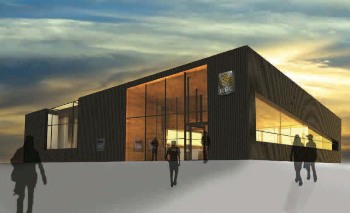Apr 19 2013
RBC and B+H proudly announced today the winners of the 2013 Evolve Sustainable Design Competition. University of Waterloo students Renee Hum-Hsiao , Elaina Poleto , Keegan Steeper , Joanne Yau and Thomas Yuan received first prize for their design of an environmentally sustainable bank branch of the future.
 RBC and B+H select winning design by University of Waterloo students Renee Hum-Hsiao , Elaina Poleto , Keegan Steeper , Joanne Yau and Thomas Yuan (CNW Group/RBC)
RBC and B+H select winning design by University of Waterloo students Renee Hum-Hsiao , Elaina Poleto , Keegan Steeper , Joanne Yau and Thomas Yuan (CNW Group/RBC)
The winning team received $5,000 and an opportunity to meet with some of Canada's top architecture professionals at B+H.
In addition, the University of Waterloo student team of Alice Chen , Alan King Bowden , Andrea Ng , Alice Song and Mina Vedut received an honourable mention and a $2,500 prize.
The competition challenged architecture and engineering students to work together in interdisciplinary teams to design a net-zero energy and water-wise bank branch of the future that incorporates innovative yet practical concepts for achieving extreme energy efficiency, includes renewable power and minimizes the branch's water.
"The winning submissions used a great balance of technology and passive design - strategies that maximize the benefits of natural light, heat and ventilation - to meet the goals of the competition," said Douglas Birkenshaw , principal at B+H. "The dedication and quality of submissions by all of the students was inspiring."
"We were very impressed with how fluent in environmental sustainability all the students were," added Lawrence Spicer , vice-president, Channel Strategy at RBC. "It is clear that sustainable design is very important to them and we're glad to support their visions for the future with a competition like Evolve."
Winner - $5,000
Renee Hum-Hsiao , Elaina Poleto , Keegan Steeper , Joanne Yau and Thomas Yuan
University of Waterloo
Design features include:
- Near net-zero energy use: a combination of design strategies focused on increasing energy efficiency, coupled with on-site energy production, allowing the branch to meet 90 per cent of its own energy needs.
- Hydronic radiant floors: heated floors powered by a geothermal system to heat the building, resulting in a simulated 28 per cent reduction in annual energy consumption.
- Building-integrated photovoltaic (PV) cells: PV, or solar cells, integrated into windows generating electricity and also acting as shading devices to reduce the need for air conditioning.
- Grey water filtration system: a combination of underground tanks, planters and permeable pavement that collects and filters rain water to be re-used in toilets.
- Sunlight transport system: a system that distributes natural sunlight through fibre optic tubing to interior spaces.
Honourable Mention - $2,500
Alice Chen , Alan King Bowden , Andrea Ng , Alice Song , and Mina Vedut
University of Waterloo
Design features include:
- Building integrated wind turbines: wind turbines incorporated into exterior walls optimized to catch prevailing winds.
- High-performance curtain wall system: south-facing wall made of alternating panels of windows with integrated PVs, or solar cells, produces energy while shading the interior.
- Operable windows: windows that open and are purposefully placed to allow for optimal natural ventilation and increased occupant comfort.
- Artificial wetland: designed for on-site water collection and filtration to help reduce storm water run-off.
- A number of passive strategies, such as thermal mass flooring and high-reflectivity roofing system, to help regulate internal temperature and reduce urban heat island effect.
Submissions were reviewed by an expert panel of judges, including:
- Douglas Birkenshaw , principal, B+H Architects
- Lawrence Spicer , vice-president of Channel Strategy, RBC
- Steve Kemp , energy modelling expert, Enermodal Engineering
- Vivian Loftness , Carnegie Mellon University, School of Architecture
- Thomas Mueller , president and CEO, Canada Green Building Council
- Lisa Rochon , architecture critic, The Globe and Mail